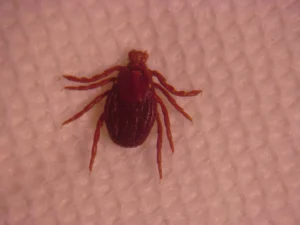Ticks are a group of parasitic organisms who typically belong to phylum Arthropoda and superorder Parasitiformes. Let us discuss some examples of ticks in detail.
- Amblyomma americanum
- Amblyomma albopictum
- Amblyomma albolimbatum
- Cosmiomma hippopotamensis
- Dermacentor albipictus
- Dermacentor auratus
- Dermacentor reticulatus
- Haemaphysalis anomala
- Haemaphysalis bispinosa
- Hyalomma dromedarii
- Ixodes anatis
- Margaropus reidi
- Rhipicephalus appendiculatus
- Antricola delacruz
- Argas brumpti
- Ornithodoros brasiliensis
- Otobius lagophilus
- Otobius megnini
- Nuttalliella namaqua
Amblyomma americanum
Amblyomma americanum is a hard ticks species also referred to as the lone star tick or turkey tick belonging to family Ixodidae. Its primary host is wild turkeys but can also attack humans as well. It lives in its host body and sucks blood but it bites painlessly.
Amblyomma albopictum
Amblyomma albopictum is one of the most common hard species belonging to the family Ixodidae. They are mostly found in different regions of Spain, France, Brazil and Mexico. Their primary host is different reptile species such as Cyclura nubila, Chilabothrus angulifer, Leiocephalus carinatus, etc.
Amblyomma albolimbatum
Amblyomma albolimbatum is one of the most common hard tick species belonging to the family Ixodidae. It is parasitizing on special reptile species such as skinks, a special group of lizards. That is why this hard tick species is also known as the stump-tailed lizard tick. It is an endemic species to Australia.
Cosmiomma hippopotamensis
Cosmiomma hippopotamensis is one of the most beautiful and rare hard tick species. They are mostly found in East and South African regions such as Namibia, Angola, and Kenya. They mostly parasitize hippopotamus and rhinoceros.
Dermacentor albipictus
Dermacentor albipictus is a hard tick species also known as the winter tick. They are distributed all across the North American regions. Moose are the primary host of winter ticks but they also parasitize different species of deer such as white-tailed deer, mule deer, elk, etc.
Dermacentor auratus
Dermacentor auratus is one of the most common tick species belonging to the family Ixodidae. They are distributed all across the Asian region including India, Sri Lanka, Indonesia, Vietnam, etc. The Dermacentor auratus mostly parasitizes wild pigs, deer, etc.
Dermacentor reticulatus
Dermacentor reticulatus is one of the most common examples of ticks typically belonging to the family Ixodidae. They are mostly found in the regions of Europe and Western Asia. The Darmacentor reticulatus are highly pathogenic and mostly infects domestic animals such as cow, dog, etc.
Haemaphysalis anomala
Haemaphysalis anomala is one of the examples of tick species belonging to the family Ixodidae. The adult form of this tick species mostly parasitizes mammals such as cattle, Bubalus bubalis, etc and the larva and nymph form parasitizes birds and small mammals.
Haemaphysalis bispinosa
Haemaphysalis bispinosa is a hard tick species mostly found in India, Sri Lanka, Pakistan, Nepal, and Indonesia regions. The tick species mostly attacks domestic mammals such as cattle, cows, goats, sheep, etc. They parasitize some bird species also. They carry the pathogen of Bartonella bovis, causing Bartonellosis in its host body.
Hyalomma dromedarii
Hyalomma dromedarii is one of the most common hard tick species that mostly parasitize camels and cattle. They are distributed all across the African and Asian regions. The H.dromedarii carries pathogens causing African Horse Sickness, Theileria, etc to its host body.
Nuttalliella namaqua
Nuttalliella namaqua is one of the examples of tick species belonging to the family Nuttalliellidae. It is distinguished from hard and soft ticks by some specific characteristics like the position of the stigmata, lack of setae, strongly corrugated integument, etc. They are mostly found in African regions.
Ixodes anatis
Ixodes anatis is a hard tick species which is endemic to New Zealand. It parasitizes North Island brown kiwi and the tokoeka as the primary host, which is why the tick species is also known as Kiwi tick.
Margaropus reidi
Margaropus reidi is one of the most common tick species belonging to the family Ixodidae. The tick species are found in South Sudan regions and mainly parasitize northern giraffes. The Margaropus reidi is also known as the Sudanese beady-legged tick.
Rhipicephalus appendiculatus
Rhipicephalus appendiculatus is one of the most common hard tick species found in African regions. They have a three host life-cycle and mostly parasitize on buffalo, cattle, antelope, dog, hare, etc. It serves as a vector for parasite Theileria parva, causing East Coast fever in its cattle hosts.
Antricola delacruz
Antricola delacruz is one of the most common soft tick species belonging to the family Argasidae. They are indigenous species found mostly in Brazilian rainforests. The tick species mostly parasitizes on cave-dwelling bats.
Argas brumpti
Argas brumpti is one of the non pathogenic soft tick species belonging to the family Argasidae. They are mostly found in eastern and southern African regions.
Ornithodoros brasiliensis
Ornithodoros brasiliensis is a soft tick species mostly found in Brazilian regions. They are parasitic on humans, dogs and some other smaller mammals. The tick species is a vector, carrying pathogenic microorganism Borrelia brasiliensis in it.
Otobius lagophilus
Otobius lagophilus is a soft tick species belonging to the family Argasidae. They parasitize rabbits, cats and attach themselves around the face and ears of the host. The Otobius lagophilus is mostly found in the United States.
Otobius megnini
Otobius megnini is a soft tick species mostly found in Southwestern United States. It is parasitic only in the larval and nymphal stages and they attach themselves around the ears of their host bodies hence also known as spinose ear tick. Some common hosts of Otobius megnini are dogs, sheep, cattle, etc.
Tick types
There are more than 900 species of ticks found worldwide, having different types of characteristics in them. Let us know about the types of ticks in detail.
Ticks are further classified into four different types, such as-
- Ixodidae
- Argasidae
- Nuttalliellidae
- Deinocrotonidae
Ixodidae
Ixodidae is a family of hard ticks having about 700 known tick species in it. They have a prominent scutum or hard shield over their body, which is why they are called hard ticks. They parasitize different types of host bodies and as a vector spread pathogens to their host bodies as well.

Nuttalliellidae
Nuttalliellidae is another type of tick mostly found in the south African regions. They possess some characteristics that distinguish them from hard ticks and soft ticks such as lack of setae, strongly corrugated integument, the form of the fenestrated plates, etc.
Argasidae
Argasidae is the family of soft ticks having about 193 known species under it. Soft ticks lack the scutum part and are not covered with a hard shield like structure hence called soft ticks.
Deinocrotonidae
Deinocrotonidae is one of the most important monotypic families of ticks that got extinct. There are only two species of this category that are identified from the Burmese amber. They have some characteristics that distinguish them from all other tick families such as the morphology of the palps, the preanal groove shape, integument structure, etc.
Conclusion
As a whole ticks are one of the most common examples of external parasites. Here we discuss some most common tick examples and also discuss the types of ticks as well. Hope our article on tick examples will be helpful to you.
Also Read:
- Cytosol and cytoplasm
- Transplanting plants examples
- Do protists have mitochondria
- Oxidoreductase enzyme example
- Dna structure detailed insights crucial aspects
- Wild plants examples
- Is lipase an enzyme
- Is adenine used in dna replication
- Dna transcription enzyme
- Analogous structures examples

Hello, I am Piyali Das, pursuing my Post Graduation in Zoology from Calcutta University. I am very passionate on Academic Article writing. My aim is to explain complex things in simple way through my writings for the readers.